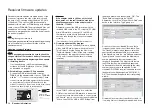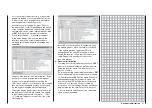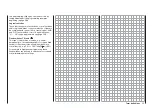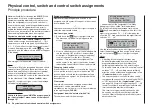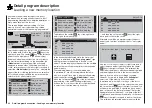
54
Term defi nitions
Term defi nitions
Control function, control, function input, control channel, mixer, switch, control switch, fi xed switch
To make use of this
mc-20
HoTT manual easier, a
number of the terms used repeatedly throughout this
manual have been defi ned below.
Control function
A "control function" is to be perceived – initially
independent of its signal path – as a signal intended
to affect a given control function. For example, this
could be for throttle, rudder or aileron in a winged
aircraft or pitch, roll or crow for a helicopter.
A control function signal can be applied directly over
a single control channel or also through a mixer and
then applied over multiple control channels. A typical
example of multiple control channels is separately
operated aileron servos or the use of two roll or crow
servos in helicopters. The control function explicitly
includes the infl uence of the control's mechanical
travel on the respective servo. This can not only
be spread or compressed by software but even the
travel characteristic can be modifi ed from linear to
extremely exponential.
Control
"Controls" include all operating elements on the
transmitter, which are directly activated by the pilot,
that impose an effect on servos, speed controllers
etc. connected to the receiver. This includes:
both
•
joysticks
for control functions 1 through
4, whereby these four functions can be freely
swapped around for both model types ("winged
aircraft" and "helicopters") by way of software
"Mode" settings, e.g. throttle left or right. The
joystick function for throttle/airbrake control is often
also referred to as the C1 control (channel 1).
both proportional controls located on the
•
transmitter's sides, which are, for example,
given the designations SD1 (right-side "rotary
slider") and SD2 (left-side "rotary slider") in the
»
Control adjust
« menu, page 108 and 112.
the three
•
proportional sliders in the middle console
designated SR1 … 3, for example as shown in the
»
Control adjust
« menu, page 108 and 112,
all fi ve
•
proportional rotary controls on the
transmitter's front side, which are, for example,
given the designations DR1 … 5 in the
»
Control adjust
« menu, page 108 and 112,
the switches present, if they are assigned to a
•
control channel in the »
Control adjust
« menu.
The proportional operating elements produce a direct
effect on servos which is commensurate with the
control's position whereas switch modules can only
effect a two or three increment change.
Just which of these controls and switches operate which
of the servos 5 … 16 (max.) is freely programmable.
Important notice:
Inputs 5 … 15 for helicopters and 5 … 16 for
winged aircraft are generally "free", i.e. not
assigned, in the transmitter's basic programming.
Function input
This is an imaginary point in the signal path and
must not be considered the same as the point on
the circuit board where the transmitter control is
connected. The choice of "
Stick mode
" and settings
in the »
Control adjust
« menu have their effect
"downstream" of these imaginary connection points.
Thus differences between the physical control's
number and the number of the downstream control
channel can indeed emerge.
Control channel
From the point at which a signal contains all control
information necessary for a particular servo – whether
directly from the physical control or indirectly by way
of a mixer – the term "control channel" is used. This
signal is only yet to be infl uenced by settings made in
the menus »
Servo adjustment
« and »
Transmitter
output
« before it leaves the transmitter's RF module.
Once it arrives at the receiver, this signal may still
be modifi ed by settings made in the telemetry menu
before fi nally being applied as a control quantity for
the respective servo.
Mixer
The transmitter's software contains a variety of mixer
functions. These can be used to apply one control
function to multiple servos or, conversely, to apply
multiple control functions to a single servo. Please
look over the numerous mixer functions in the text
beginning on page 159 of this manual.
Switches
The four standard toggle switches, the two 3-way
switches and both push-button switches can also
be incorporated into control programming. However,
these switches are generally intended for switching
program options, e.g. to start and stop timers, to
switch mixers on and off, or as a teacher/pupil
switchover, etc. Each of these switches can be
assigned any number of functions.
Appropriate examples are detailed in the manual.
Control switches
Since it is very practical to have some functions
automatically switched on or off for a certain control's
position (e.g. switch on/off of a stopwatch for
acquisition of model run time, automatic extension of
spoilers and other possibilities), eight control switches
have been integrated into
mc-20
HoTT software.
These software switches, designated "C1 … C8", are
merely defi ned by virtue of their contact state along
the physical control's course of travel by the touch of
a key. The switching action can be correlated to the
physical control's travel direction by software.
Of course control switches can also be freely
combined with the aforementioned physical switches
to solve even more complex problems.
There is a series of instructive examples which make
Содержание 32032
Страница 1: ...33020 mc 20HoTT 2 en Programming Manual o Pro Pro mc 20 mc 20...
Страница 15: ...15 For your notes...
Страница 21: ......
Страница 27: ...27 For your notes...
Страница 41: ...41 For your notes...
Страница 53: ...53 For your notes...
Страница 59: ...59 For your notes...
Страница 63: ...63 For your notes...
Страница 93: ...93 For your notes...
Страница 97: ...97 For your notes...
Страница 141: ...141 How is a ight phase programmed...
Страница 145: ...145 For your notes...
Страница 155: ...155 For your notes...
Страница 175: ...175 For your notes...
Страница 203: ...203 For your notes...
Страница 219: ...219 For your notes...
Страница 253: ...253 For your notes...
Страница 283: ...283 For your notes...
Страница 321: ...321 For your notes...
Страница 322: ...322 For your notes...
Страница 323: ...323 For your notes...











